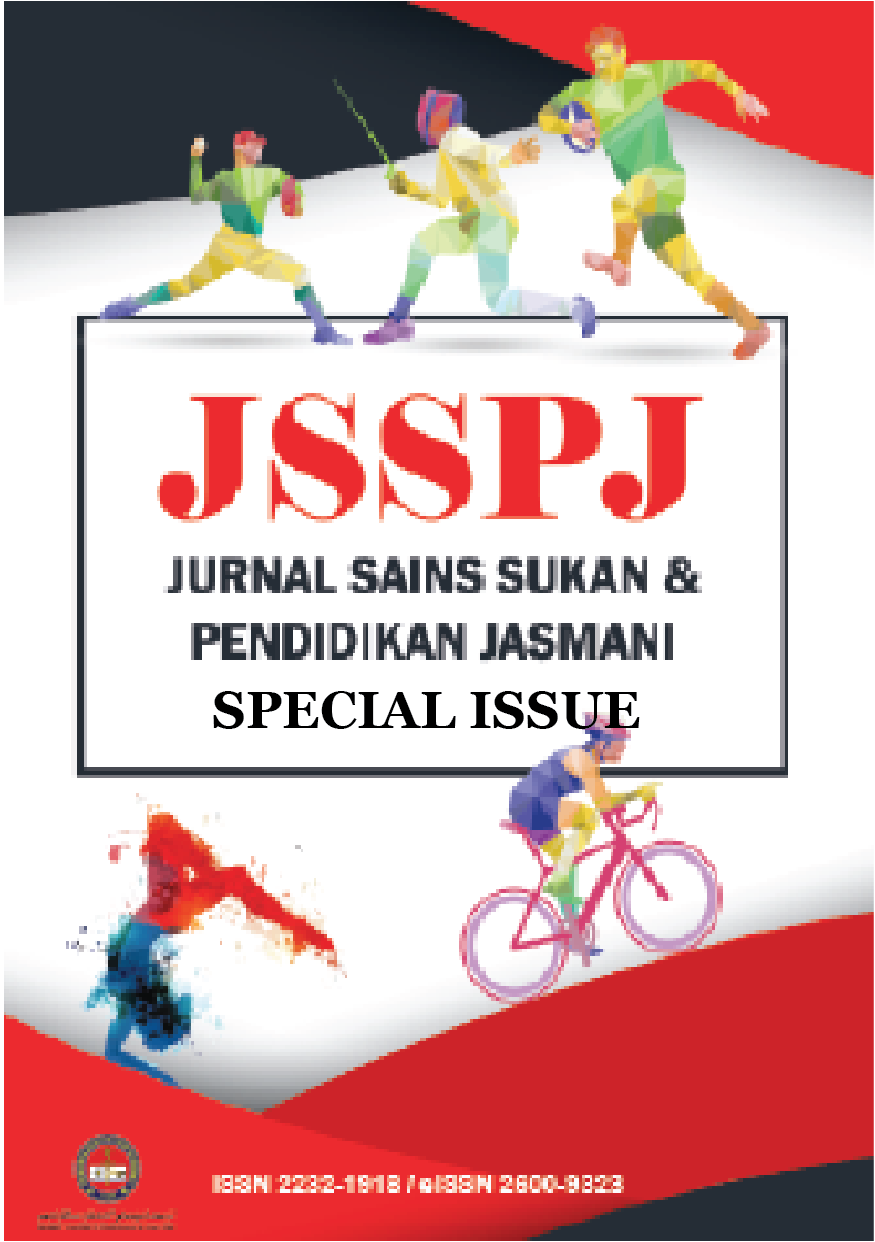Level of Mental Health Among Physical Education Teachers During COVID-19 Pandemic
Tahap Kesihatan Mental Guru Pendidikan Jasmani Semasa Pandemik COVID-19
DOI:
https://doi.org/10.37134/jsspj.vol11.sp.11.2022Keywords:
Covid-19, depression, anxiety, stress, Physical Education teachersAbstract
This study aims to investigate the status of mental health among Physical Education (PE) teachers Gombak, Selangor during the pandemic of Covid-19A total of 124 primary school PE teachers in Gombak district were selected randomly to be sampled for this study. A set of questionnaires consisted of three sections covering the background of the respondent, a section for measuring the level of mental health using the Depression, Anxiety and Stress Scale (DASS-21) instrument and a section using Global Physical Activity Questionnaire Malay Version (GPAQ-M) instrument translation by Soo et al. (2015) to measure the physical level of activity by focusing on the teachers sedentary. The data were analysed using Statistic Packages for Social Science (SPSS) version 22.0 involved descriptive statistics and inference analysis. The result showed that the teacher’s mental health in depression was at normal levels, while anxiety and stress level were moderate. Furthermore, the result show that there is a significant positive relationship between the anxiety (r=0.322, p=0.000) and stress (r=0.240, p=0.007) with sedentary level. While the depression (r=-0.121, p=0.180) showed no significant association with sedentary level. In conclusion, the mental health status among PE teachers during the pandemic of Covid-19 was normal and not worrying.
Downloads
References
Desouky, D., & Allam, H. (2017). Occupational stress, anxiety and depression among Egyptian teachers. Journal of Epidemiology and Global Health, 7(3), 191-198.
Fazura Mohd Noor, Mohd Burhan Ibrahim & Tajul Ashikin Jumahat. (2013). Faktor-faktor Penentu Tekanan dalam Kalangan Guru di Sekolah Rendah Mubaligh Kuala Lumpur. Jurnal Kurikulum & Pengajaran Asia Pasifik, 1(2).
Hamdan Hamami. (2013). Beban Tugas Guru di Sekolah Kebangsaan Daerah Kota Tinggi. Disertasi Master, Universiti Teknologi Malaysia. Retrieved from http://eprints.utm.my/id/eprint/41596/
Jakubowski, T. D., & Magdalena Maja Sitko-Dominik. (2021). Teachers’ mental health during the first two waves of the COVID-19 pandemic in Poland. PLoS One, 16(9).
Johari Hassan & Nornazifah Md Suandi. (2010). Kajian Terhadap Stress di Kalangan Guru Sekolah di Zon Permas Jaya, Johor Bahru Dari Aspek Personaliti. Universtiti Teknologi Malaysia.
Institute for Public Health. (2015) Tinjauan Kesihatan dan Morbiditi (NHMS). Retrieved from https://iku.gov.my/nhms-2015
Marashi, M. Y., Nicholson, E., Ogrodnik, M., Fenesi, B., & Heisz, J. J. (2021). A mental health paradox: Mental health was both a motivator and barrier to physical activity during the COVID-19 pandemic. PLoS One, 16(4)
Ozamiz-Etxebarria, N., Mondragon, N. I., Bueno-Notivol, J., Pérez-Moreno, M., & Santabárbara, J. (2021). Prevalence of anxiety, depression, and stress among teachers during the COVID-19 pandemic: A rapid systematic review with meta-analysis. Brain Sciences, 11(9), 1172.
Pengpid, S., & Peltzer, K. (2019). Sedentary Behaviour, Physical Activity and Life Satisfaction, Happiness and Perceived Health Status in University Students from 24 Countries. Int. J. Environ. Res. Public Health, 16(2084).
Randall, K., Ford, T. G., Kwon, K., Sisson, S. S., Bice, M. R., Dinkel, D., & Tsotsoros, J. (2021). Physical activity, physical well-being, and psychological well-being: Associations with life satisfaction during the COVID-19 pandemic among early childhood educators. International Journal of Environmental Research and Public Health, 18(18), 9430.
Shillington, Katie J; Vanderloo, Leigh M; Burke, Shauna M; Ng, Victor; Tucker, P. et al. (2021). Ontario adults’ health behaviors, mental health, and overall well-being during the COVID-19 pandemic. BMC Public Health, 21, 1–15.
Singh, Amrinder; Mall, Sachin; Shenoy, Shweta; Sandhu, J. (2021). Trait anxiety and stress level among university students and teachers: A comparative study. Indian Journal of Social Psychiatry, 37,219-224
Solanki, S., & Mandaviya, M. (2021). Does gender matter? Job stress, work-life balance, health and job satisfaction among university teachers in India. Journal of International Women’s Studies, 27(7), 121–134.
World Health Organization. (2020). WHO Guidelines on physical activity and sedentary behaviour for children and adolescents, adults and older adults. Retrieved from https://www.who.int/docs/default-source/physical-activity/call-for-consultation/draft-guideline-on-physical-activity-and-sedentray-behaviour.pdf?sfvrsn=ddf523d5_4#:~:text=For%20adults%2C%20sedentary%20behaviour%20is,and%20community%20settings%20and%20transportation.
Downloads
Published
Issue
Section
License
Copyright (c) 2022 Nur Zaheeda Zainol Azlan, Mohd Azrul Anuar Zolkafi, Nor Fadila Kasim

This work is licensed under a Creative Commons Attribution-NonCommercial-ShareAlike 4.0 International License.





